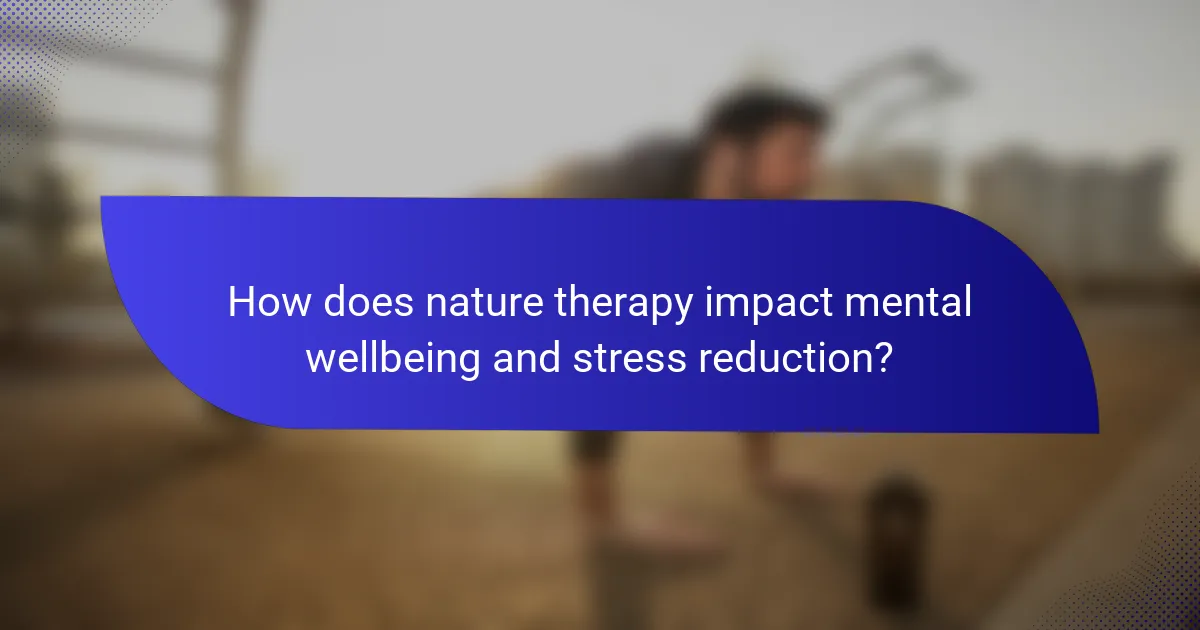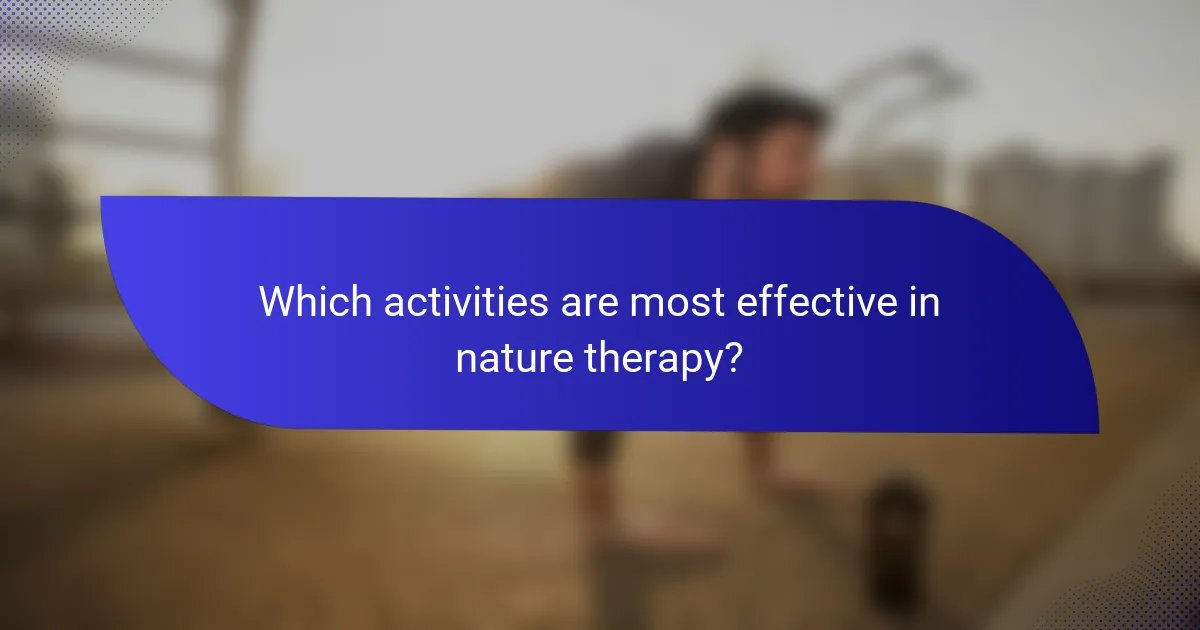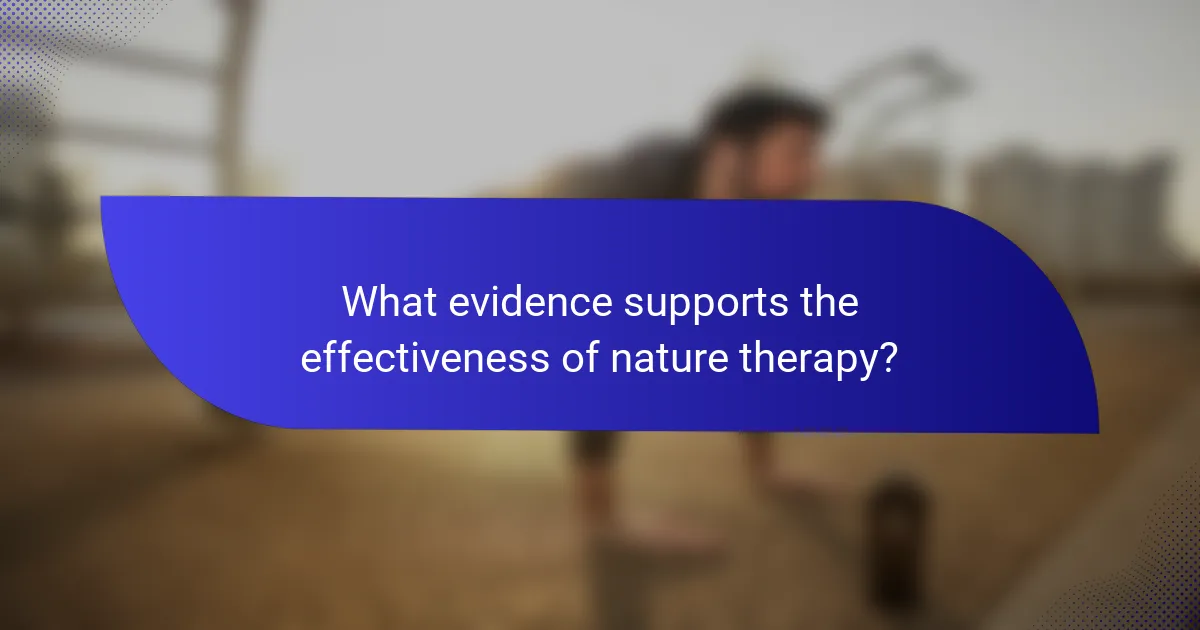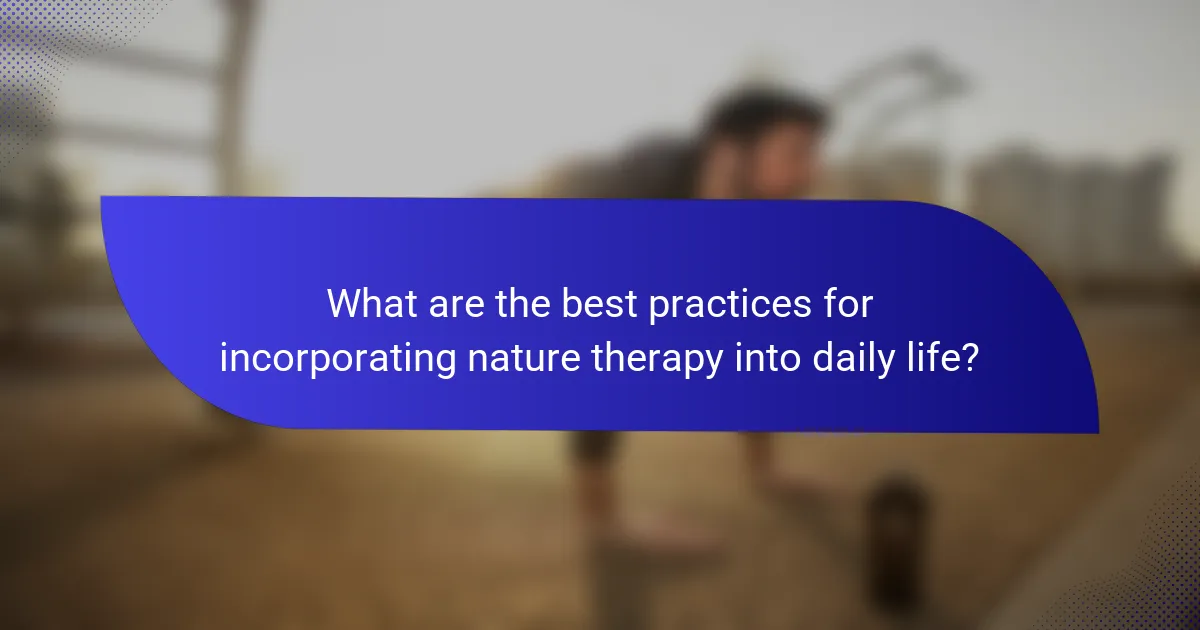Nature therapy significantly enhances mental wellbeing and reduces stress, making it a valuable approach for many individuals. Engaging in activities like forest bathing, gardening, hiking, and mindfulness practices outdoors fosters relaxation and improves mood. However, challenges such as accessibility and individual responses can impact its effectiveness. This article explores the benefits of nature therapy, its unique attributes, and practical ways to incorporate it into daily life.

How does nature therapy impact mental wellbeing and stress reduction?
Nature therapy significantly enhances mental wellbeing and reduces stress. Engaging with natural environments fosters relaxation and improves mood. Studies show that spending time outdoors can lower cortisol levels, which are linked to stress. Nature therapy also promotes mindfulness, allowing individuals to focus on the present moment, further alleviating anxiety. Additionally, exposure to greenery has been associated with improved cognitive function and emotional resilience, making it a valuable tool for mental health.
What are the psychological benefits of engaging with nature?
Engaging with nature provides significant psychological benefits, including reduced stress and improved mental wellbeing. Nature therapy enhances mood, lowers anxiety levels, and fosters a sense of connection. Studies indicate that spending time in green spaces can lead to lower cortisol levels, promoting relaxation. Additionally, exposure to natural environments encourages mindfulness, which further contributes to emotional resilience.
How does exposure to natural environments influence mood and anxiety levels?
Exposure to natural environments significantly improves mood and reduces anxiety levels. Nature therapy promotes mental wellbeing through various mechanisms, including stress reduction and enhanced emotional resilience. Studies show that spending time in green spaces leads to lower cortisol levels, which is linked to stress. Additionally, natural settings encourage physical activity, which further alleviates anxiety symptoms. Engaging with nature fosters mindfulness and a sense of connection, contributing to overall mental health improvements.

Which activities are most effective in nature therapy?
Nature therapy is most effective through activities such as forest bathing, gardening, hiking, and mindfulness practices outdoors. These activities enhance mental wellbeing and reduce stress by fostering a connection with nature.
1. Forest bathing: Immerses individuals in a natural environment, promoting relaxation and reducing cortisol levels.
2. Gardening: Engages physical activity and mindfulness, providing a sense of accomplishment and purpose.
3. Hiking: Combines physical exercise with nature exposure, boosting mood and overall mental health.
4. Mindfulness practices: Encourages present-moment awareness in natural settings, enhancing emotional regulation and reducing anxiety.
What role do mindfulness practices play in nature therapy?
Mindfulness practices enhance nature therapy by promoting present-moment awareness and reducing stress. These techniques encourage individuals to engage deeply with their surroundings, fostering emotional regulation and mental clarity. Research indicates that mindfulness in nature can lead to significant reductions in anxiety and depression levels. Additionally, combining mindfulness with nature therapy can improve overall mental wellbeing by enhancing the therapeutic effects of natural environments.
How can outdoor physical activities enhance mental health?
Outdoor physical activities significantly enhance mental health by promoting relaxation and reducing stress. Engaging with nature fosters a sense of connection and improves mood. Studies show that spending time outdoors can lower anxiety levels and boost overall emotional wellbeing. Nature therapy has unique benefits, such as increasing mindfulness and providing a rare opportunity for social interaction in a calming environment. Regular outdoor activities can lead to long-term mental health improvements, making them a valuable tool for stress reduction.

What are the common challenges faced in nature therapy?
Common challenges in nature therapy include accessibility, weather conditions, and varying individual responses. For many, accessing natural spaces can be difficult due to location or mobility issues. Weather can disrupt planned activities, impacting the effectiveness of therapy sessions. Additionally, individuals may respond differently to nature therapy, with some experiencing minimal benefits. Understanding these challenges can enhance the effectiveness of nature therapy for mental wellbeing and stress reduction.
How can accessibility issues affect participation in nature therapy?
Accessibility issues can significantly hinder participation in nature therapy. Physical barriers, such as uneven terrain or lack of wheelchair access, limit individuals with mobility challenges. Additionally, sensory overload from natural environments can affect those with sensory processing disorders. Mental health barriers, including anxiety or depression, may deter individuals from engaging with nature. Inclusive design and supportive programs can enhance accessibility, fostering broader participation in nature therapy for mental wellbeing and stress reduction.
What barriers do individuals face in integrating nature therapy into their routine?
Individuals face several barriers in integrating nature therapy into their routine, including time constraints, lack of access to natural spaces, and insufficient knowledge about its benefits. Many people struggle to prioritize outdoor activities amidst busy schedules. Urban environments often limit access to green spaces, making it challenging to engage in nature therapy. Additionally, a lack of awareness about how nature therapy can improve mental wellbeing and reduce stress may prevent individuals from adopting this practice.

Which specific populations benefit most from nature therapy?
Individuals with anxiety, depression, and PTSD benefit most from nature therapy. Research shows that exposure to natural environments reduces stress and enhances mood. Children with ADHD also experience improved focus and behavioral outcomes through nature therapy. Additionally, seniors facing isolation find solace and community engagement in natural settings. Those recovering from addiction may experience reduced cravings and improved emotional resilience. Thus, nature therapy serves diverse populations by promoting mental wellbeing and stress reduction.
How does nature therapy support mental health in children?
Nature therapy significantly enhances mental health in children by promoting emotional resilience and reducing stress. Engaging with natural environments fosters creativity and improves mood. Studies show that children exposed to nature exhibit lower anxiety levels and enhanced focus. Additionally, nature therapy encourages physical activity, which is linked to better mental wellbeing. This holistic approach supports social skills through group activities in outdoor settings, creating a positive impact on overall development.
What are the advantages of nature therapy for elderly individuals?
Nature therapy offers numerous advantages for elderly individuals, enhancing mental wellbeing and reducing stress. Engaging with nature improves mood, fosters social connections, and promotes physical activity.
Research indicates that spending time outdoors can decrease symptoms of anxiety and depression, leading to a more positive outlook. Nature therapy also encourages mindfulness, allowing seniors to focus on the present and appreciate their surroundings. Additionally, exposure to natural environments can enhance cognitive function, which is crucial for maintaining mental acuity in older age.
Overall, nature therapy serves as a holistic approach to improving the quality of life for elderly individuals by addressing both mental and emotional health.

What unique attributes set nature therapy apart from traditional therapy?
Nature therapy uniquely emphasizes the healing power of natural environments, distinguishing it from traditional therapy. It fosters deep connections with nature, enhancing emotional resilience. Nature therapy often involves physical activities like hiking or gardening, which can improve mood and reduce stress. Additionally, it promotes mindfulness through sensory experiences, such as listening to birds or observing plants. This immersive approach contrasts with conventional therapy’s focus on verbal communication and indoor settings. Nature therapy’s unique attribute is its ability to combine physical activity with mental healing, leading to holistic well-being.
How does the sensory experience in nature differ from indoor environments?
Nature therapy provides a richer sensory experience than indoor environments, enhancing mental wellbeing and reducing stress. Natural settings stimulate multiple senses through varied sounds, scents, and visuals, promoting relaxation and mindfulness. Research indicates that exposure to nature can lower cortisol levels and improve mood, whereas indoor spaces often lack these sensory stimuli. Engaging with nature can lead to unique experiences such as the calming sound of rustling leaves or the fresh scent of pine, which are rarely replicated indoors.
What are the distinctive practices in nature therapy compared to other therapeutic approaches?
Nature therapy uniquely emphasizes direct interaction with nature for mental wellbeing and stress reduction. Unlike traditional therapies, it incorporates outdoor environments, promoting mindfulness through natural settings.
Distinctive practices include guided nature walks, forest bathing, and nature journaling, which foster emotional healing. These methods contrast with conventional approaches that often rely on indoor settings and verbal communication.
Research indicates that nature therapy can significantly lower cortisol levels, enhancing relaxation compared to standard therapeutic practices. This unique attribute of nature therapy demonstrates its effectiveness in stress reduction and overall mental health improvement.
Additionally, nature therapy encourages physical activity, which is less emphasized in other therapeutic approaches, further contributing to mental wellbeing and resilience.

What evidence supports the effectiveness of nature therapy?
Nature therapy effectively enhances mental wellbeing and reduces stress, supported by various studies. Research indicates that spending time in natural environments lowers cortisol levels, a key stress hormone. Additionally, a meta-analysis found that nature-based interventions significantly improve mood and cognitive function. For example, participants reported increased feelings of calm and reduced anxiety after engaging in outdoor activities. Furthermore, studies show that nature therapy can enhance social connections, promoting a sense of belonging and community. These findings highlight nature therapy’s multifaceted benefits for mental health.
Which studies highlight the positive outcomes of nature therapy?
Studies consistently show that nature therapy significantly enhances mental wellbeing and reduces stress. Research indicates that spending time in natural environments can lower cortisol levels, improve mood, and increase overall life satisfaction. For instance, a study published in the Journal of Environmental Psychology found that participants reported a 20% increase in happiness after engaging in nature therapy sessions. Another research highlighted that individuals who regularly practice nature therapy experience decreased symptoms of anxiety and depression, with 70% reporting improved emotional resilience. These findings underscore the therapeutic benefits of nature in promoting mental health.
What metrics are used to measure the success of nature therapy interventions?
Metrics used to measure the success of nature therapy interventions include psychological assessments, physiological measures, and participant feedback. Common metrics are stress levels, mood improvement, and overall wellbeing.
| Metric | Description | Value |
|—————————-|——————————————-|———————————-|
| Stress Level Reduction | Change in cortisol levels | 30% decrease post-intervention |
| Mood Improvement | Increase in positive affect scores | 25% increase in self-reports |
| Overall Wellbeing Score | Composite measure from various scales | 15% improvement in wellbeing index|
| Participant Satisfaction | Feedback on therapy experience | 90% satisfaction rate |
| Nature Connection Rating | Level of connection felt with nature | 40% increase in connection scores |
| Anxiety Reduction | Change in anxiety scale scores | 35% decrease in anxiety levels |

What are the best practices for incorporating nature therapy into daily life?
To incorporate nature therapy into daily life, prioritize regular outdoor activities and mindfulness practices. Engage in activities such as walking, gardening, or simply sitting in a park to enhance mental wellbeing and reduce stress.
1. Schedule daily outdoor time, aiming for at least 30 minutes.
2. Practice mindfulness in nature by focusing on sounds, sights, and smells.
3. Create a nature-inspired space at home with plants or natural elements.
4. Join community groups for nature walks or conservation efforts.
5. Use nature as a backdrop for relaxation techniques like meditation or yoga.
6. Document your experiences in nature to reflect on benefits and progress.
How can individuals create their own nature therapy routines?
Individuals can create their own nature therapy routines by incorporating outdoor activities that promote mental wellbeing and reduce stress. Start by identifying local natural spaces, such as parks or forests, where you can spend time. Engage in activities like walking, hiking, or simply sitting in nature to enhance your connection with the environment.
Establish a routine by scheduling regular visits to these natural spaces. Aim for at least 30 minutes of exposure to nature several times a week. This frequency can significantly improve mood and reduce anxiety. Consider incorporating mindfulness practices, such as deep breathing or meditation, during your time outdoors to deepen the therapeutic effects.
Experiment with different environments and activities to discover what resonates best with you. Whether it’s gardening, birdwatching, or practicing yoga in a serene setting, personalizing your routine will enhance its effectiveness. Keep a journal to track your experiences and feelings, noting any changes in your mental wellbeing over time.
What expert tips can enhance the effectiveness of nature therapy experiences?
Engaging in nature therapy can be enhanced by incorporating specific expert tips. Prioritize regular exposure to natural environments, as consistent interaction improves mental wellbeing. Set clear intentions for each session, focusing on specific goals such as relaxation or mindfulness. Utilize sensory engagement techniques, such as observing sounds or textures, to deepen the experience. Lastly, consider group settings for shared experiences, which can foster connection and support.